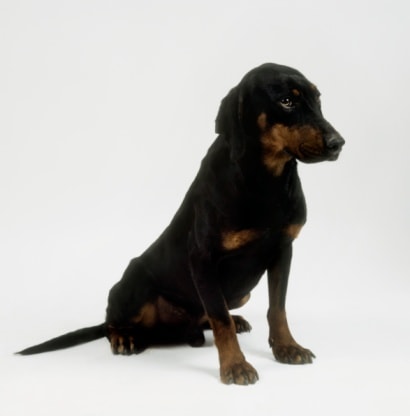Type the name of the breed you're looking for below
[wpdreams_ajaxsearchlite] Don't see the breed your're looking for? Click here and let us know!
Breed Characteristics
1 paw - breed exhibits the least amount of this characteristic
5 paws - breed exhibits most amount of this characteristic
Montenegrin Mountain Hound
| Other Names | Montenegrin, Crnogorski planinski gonič, Serbian Mountain Hound, Yugoslavian Mountain Hound |
| Country of Origin | Montenegro |
| Weight | 44 - 55 lbs. (20 - 25 kg) |
| Height (at withers) | 18 - 22 in. (46 to 56 cm) |
| Coat | Double coat with short, dense, rough, not thick, glossy, flat, smooth overcoat and well developed undercoat. |
| Colour | Black with tan markings |
| Litter Size | 2 - 8 puppies, average 4 - 5 |
| Life Span | 11 - 14 years |
| Origin & History | The Montenegrin Mountain Hound is a rare dog breed from the mountain regions across the Balkans. The Montenegrin Mountain Hound was called Black Hound in the past. We can say with certainty that this breed is of the same origin as the other Balkan hounds. The breed was formerly known as the Yugoslavian Mountain Hound; the FCI changed the name on July 15, 1997. The first standard dates back to 1924. The breed bears strong resemblance to the Austrian Black and Tan Hound. The breed was first officially recognized on May 8, 1969 in Warsaw. American Rare Breed Association considers the breed endangered. |
| Personality | This unspoiled breed is steady in character and temperament. Responsive to and trusting of his owners, he is a fine hunter as well as a all-around family companion. |
Care Requirements
| Health | There are no known breed-specific health concerns. |
| Grooming | This dog does not require a large amount of grooming. Their smooth short-haired coat is easy to look after. Owners will simply want to make sure the coat is brushed on a consistent basis. These dogs should only be given baths when they need it. A wipe down with a damp towel should suffice for the bathing aspect, (although you should bathe it with mild soap only if or when necessary; you should also dry shampoo it occasionally), however a rubber, wire, or hard bristled brush would work best for the brushing aspect. The shedding patterns of these dogs are not known. Be sure to check the ears carefully for signs of infection. The nails should also be trimmed, (particularly to avoid nail-born infections). |
| Exercise | It should be taken on walks daily, and this dog is great for healthy people who love to jog and hike. |
| Other Considerations | While it can live in an apartment, it may perform better in a small yard. It is important for owners to make sure these dogs are given lots of space to move around in. |



